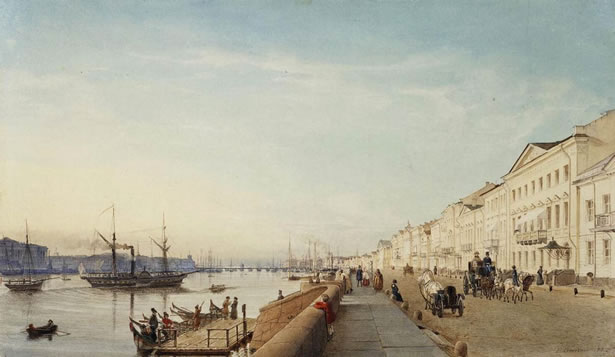Never a large community but an old and an influential one, British merchants began to arrive in the first years after its foundation by Peter the Great in 1703. For the next two centuries they were to exercise a remarkable influence on the city’s economic development, drawing in their wake British soldiers, sailors, bankers, engineers, manufacturers, doctors, architects and craftsmen. By the 1820’s some 2,500 families lived in the city, some in aristocratic comfort: ‘proud of their indispensableness and the invincibility of their fleets’, one disgruntled German observer wrote, ‘highly thought of by the government and by all, because they think highly of themselves, and reside chiefly in the magnificent quay named after them’.
By the end of the eighteenth century the city’s first grand embankment along the Neva had become ‘English’. The hero of ‘To Kill A Tsar’, Frederick Hadfield belongs to a family very like the Greig family, who lived at number 62 on the English Embankment for more than a hundred years. A Scot of modest background, the founder of the family’s fortunes, Samuel Greig, distinguished himself in Catherine the Great’s navy, rising to the rank of admiral of the Russian Empire. The next three generations of the Greig family served the tsars as admirals, generals and government ministers, marrying into the Russian aristocracy without entirely losing their connection to Britain. A little further along the embankment from number 62 is the broad blue and white mansion that was once owned by Sir James Wylie, another Scot and a doctor who served as personal physician to three tsars. Another famous Scottish physician, John Rogerson, lived at number 21; at number 70 the prominent banker Samuel Gwyer; at number 38 Clarke the grain merchant, and at number 6 the Cazalet family who owned a rope factory, the capital’s largest brewery, a tallow processing plant, and was involved in banking and the development of the railway.

The English Embankment in 1835. Eduard Gärtner.
In the city beyond the English Embankment, embassy records for the second half of the nineteenth century list the occupations of other British residents as jockey, accountant, ringmaster, cotton mill manager, clerk, carder, electrical engineer, foreman printer and brewer.
There were really only two types of ‘Britishers’ in St Petersburg at the end of the nineteenth century; those who spoke Russian, educated their children in the city and were comfortable in society, and a smaller group who made little or no attempt to integrate. There was an English speaking prep school for this group – the older children of the rich were sent ‘home’ to a public school – tennis and yacht clubs, an English Church, an English shop on the Nevsky Prospekt and an English Gentleman’s Club.
Frederick Hadfield belongs to the former type: St Petersburg is his home. He was forced to leave the city at the age of 11 when his father died, but did not settle at boarding school in England where his heavily accented English and interest in Russia set him apart from his peers. After university and a short spell as a doctor in London, he returns to the city, his Russian family and the life of the English Embankment.
